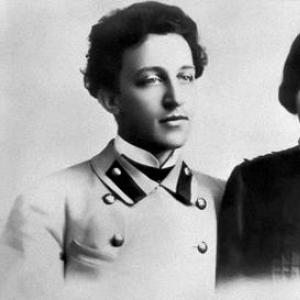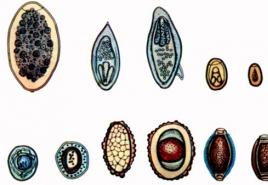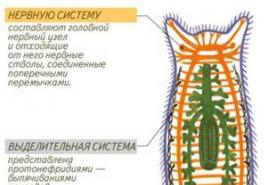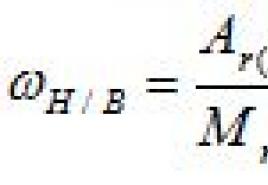Flatworms name meaning and habitat. Aquatic and soil habitat Flatworm habitat and lifestyle
§ 1 Habitats and external structure of Flatworms
Type: Flatworms have about 15 thousand species of animals. Flatworms are found in all habitats: aquatic, soil, ground-air, and organismal. Their body sizes vary from half a millimeter to 15 meters. However, despite such a variety of species, all representatives of this type have a number of common features.
All representatives of Flatworms are multicellular animals and have bilateral body symmetry. Let's remember what symmetry is. Symmetry in biology is the regular arrangement of identical parts of the body relative to the center, which is called the axis of symmetry. Bilateral symmetry means that one side of the animal's body is a mirror image of the other side.
An important feature of the external structure of representatives of this type of animals is also the flattened top and bottom body shape. Outside, the body of the Flatworms is covered with only one layer of epithelium, under which there are 3 layers of muscles. The set of skin and musculature of worms is usually called the skin-muscular sac.
§ 2 Internal structure of flatworms

Speaking about the internal structure of this type of animals, it must be remembered that the circulatory and respiratory systems are absent. They are characterized by aerobic or anaerobic respiration. Oxygen enters the body through the entire surface of the body.
The digestive system of flatworms is represented by the mouth, pharynx, and highly branched intestines. However, the back of the intestine and the anus are missing, so undigested food debris is excreted through the mouth.
The work of the excretory system is aimed at removing excess water and some metabolic products from the body. In flatworms, it is represented by a whole network of branched tubules, which are located along the entire body, uniting in 1 or 2 excretory canals, they open at the posterior end of the body.
A pair of supraopharyngeal nerve nodes and longitudinal nerve trunks, connected by cords, form the nervous system. From the sense organs, Flatworms have light-sensitive eyes, special organs of balance, and tactile cells.
Most Flatworm species are hermaphrodites. Hermaphrodites are animals whose bodies contain both the organs of both the male and female reproductive systems. Despite this, 2 individuals participate in the fertilization process.
§ 3 Systematics of Flatworms
The Type Flatworms are divided into 3 main Classes, namely the Ciliated Worms Class, the Flukes Class and the Tapeworms Class.

The class Ciliated worms includes about 3.5 thousand species of animals. Most ciliated worms are free-living, i.e. they live in any habitat, with the exception of the organismic one. Their skin is covered with cilia, which gave the name to this class. Due to muscle contraction, the cilia move, thereby moving the body in space. The most famous members of the Ciliated Worms Class are: Milky Planaria, Black Planaria and Multi-Eyed.


List of used literature:
- Konstantinov V.M. Lesson planning for the textbook “Biology. Animals "for the 7th grade, VM Konstantinov, VG Babenko, VS Kumchenko. / Konstantinov V.M. - M .: Ventana-Graf, 2005 .-- 304s.
- World Encyclopedia: Biology / Ch. ed. M.V. Adamchik: Ch. scientific. Ed. V.V. Adamchik: Minsk: Contemporary Literary, 2004. - 832s.
- Iontseva A.Yu. Biology in diagrams and tables / A.Yu. Iontseva, A.V. Torgalov. - M .: Eksmo, 2014 .-- 352s.
- Sadovnichenko Yu.A. Biology / Yu.A. Sadovnichenko. - M .: Eksmo, 2013 .-- 512s.
- Biology: a guide for applicants to universities: In 2 volumes. Vol. 1. - 2nd ed., Rev. and add. - M .: RIA "New Wave": Publisher Umerenkov, 2012. - 512s.
Used images:
summaries of other presentations"Features of the structure of the planarian" - The internal structure of the white planarian. White planaria or milky. White planaria. General characteristics of the type. The structure of the white planaria. Common signs. The excretory system of the planaria. Ciliary worms. Coelenterates. Variety of flatworms. Regeneration of the planarian body. White planaria. Various types of planaria. Bilateral and radial symmetry of the body. Planarian and Hydra body layers. The internal structure of the planaria.
"The structure of flatworms" - Movement. Digestive system of flukes. Nervous system. Senses. Ciliary worms. Turbellaria. Excretory system. The reproductive system. Life cycles of tapeworms. The reproductive system of flukes. Flukes are very fertile. Fluke class. Gas exchange and transport of substances. Ciliary digestive system. Type Flatworms. Tapeworms. Development of flukes. The reproductive system is tape.
"Planarian structure" - Type Flatworms. Excretory system. The appearance of the third germ layer during development. The eggs are covered with dense shells. Milk planaria. Space between organs. Planarian movements. The reproductive system. Digestive system. Signs of flatworms. Planarian body. Type Ciliary worms. Flat worms. The internal structure of the planaria. Ring muscles. Monolayer epithelium. Nervous system.
"The structure of the white planaria" - The integument of the body. Plathelminthes. Nephridia and kidney accumulation. A variety of flatworms. Group members. Flat worms. The structure of the planaria. Structure. Grabbing food by white planaria. Muscle location. Nervous system and senses. Musculature. Pharynx and intestines. Food and movement. Complication of the body cavity. Turbellaria class. Ringed worms. The nervous system of the white planaria.

Structural features Bilaterally asymmetric - the only cavity of symmetry divides the body into left and right halves. Development occurs from three germ layers: ectoderm, endoderm and mesoderm. The third germ layer appears for the first time in the course of evolution and gives rise to the development of parenchymal cells that fill the gaps between the organs and the muscular system. Left half Right half

Structural features Body dimensions from 2-3 mm to 20 m. The body is elongated and flattened in the dorsal-abdominal direction; has a ribbon-like or leaf-like shape. The presence of developed organ systems is characteristic: muscular, digestive (absent in tape), excretory nervous and sexual.

Body integument and muscular system Epithelial and muscle cells are separate formations. The musculocutaneous sac consists of a single-layer epithelium (in aquatic forms the epithelium has cilia) and three layers of smooth muscles: annular, longitudinal and oblique). Some also have abdominal muscles. Movement is provided by muscle contraction (flukes and tapeworms) or cilia of the integumentary epithelium and muscle contraction (ciliary worms).


Digestive system Has two sections - front (mouth, pharynx) and middle (bowel branches). The intestine is closed blindly, the posterior intestine and the anus are absent. Undigested food debris is removed by mouth. In tapeworms, the digestive system is absent (represented by individual digestive cells).

Excretory system Formed by a system of tubules, one end of which begins in the parenchyma with a stellate cell with a bundle of cilia, and the other flows into the excretory duct. The duct is combined into one or two common channels, ending with excretory pores.

Nervous system. Senses. It consists of the supraopharyngeal nerve nodes (ganglia) and longitudinal nerve trunks that run along the body and are connected by transverse nerve bridges. Sense organs - touch and chemical sense. Free-living people have organs of touch and balance.

Hepatic flukes Hepatic flukes, usually 3 cm long and 1.3 cm wide. Hepatic flukes of the Opisthorchis order cause opisthorchiasis, symptoms of an early stage - enlargement of the liver, allergic reactions and gastrointestinal disorders; late-stage symptoms - back pain, bilious colic, headaches and dizziness, insomnia. Treatment is carried out with anthelmintic, choleretic and enzyme preparations. High frequency electromagnetic radiation is also used.

Development cycle The life cycles of different genera differ. In species of the genus Fasciola, development occurs with one intermediate host (freshwater snail), and infection of the final host occurs when swallowed with water or eaten with coastal plants of the dormant stage - adolescaria. In the species of the genera Opisthorchis and Clonorchis, freshwater fish is the second intermediate host, and infection of the final host occurs when raw fish with invasive stages are eaten. In species of the genus Dicrocoelium, terrestrial lung snails and ants serve as intermediate hosts, and infection of the final host (usually a herbivore) occurs when an infected ant is eaten with grass.

Bovine tapeworm (tapeworm) Affects cattle and humans, causing teniarinhoses. Bovine tapeworm infection is especially common in equatorial Africa, Latin America, the Philippines and parts of eastern Europe. An adult bovine tapeworm consists of more than 1000 segments and reaches 4-40 meters in length. The laying of the genital apparatus begins from about the 200th segment. Mature proglottids are mm long, 5-7 mm wide. The scolex (head section) is equipped with 4 suction cups without hooks (therefore unarmed). The life span of a bovine tapeworm in the human intestine, if no deworming measures are taken, is years. The tapeworm produces ~ 600 million eggs per year, and ~ 11 billion eggs in a lifetime.

Development cycle Segments containing eggs are released from the human intestine (the main host). Together with the grass, they enter the cow's stomach (intermediate host). Six-hooked larvae emerge from the eggs, which penetrate into the blood vessels of the intestine and then into the muscles. In the muscles, the larva turns into Finns (a vial with a tapeworm head inside). When a person eats poorly processed phynose meat, the head of the tapeworm attaches to the intestinal wall and begins to produce segments.


Structural features Bilaterally asymmetric. Sizes from several micrometers (soil) to several meters (sperm whale nematode). They have an unsegmented body with a dense cuticle. The ciliary cover is partially or completely reduced. The body is filiform, fusiform, non-segmented, round in cross section.


Digestive system Formed by the anterior, middle and hind gut. The anterior gut is differentiated into sections: the mouth with cuticular lips, the pharynx and the esophagus. The middle and hind gut are not divided into sections. The digestive tract ends with the anus.

The excretory system is represented by 1-2 cutaneous glands (modified protonephridia). These are large cells, from which two channels extend on the sides of the cell. At the posterior end of the body, the channels end blindly, and in the front they open into the external environment by the excretory pore.

Nervous system. Sensory organs Ladder-type nervous system. It is represented by the head nerve nodes (ganglia), the periopharyngeal nerve ring and several nerve trunks (dorsal and ventral), median transverse bridges. The sense organs are represented by the organs of touch and the chemical sense. Marine forms have light-sensitive receptors. Diagram of the ascaris nervous system: 1 - oral papillae with tactile endings and nerves innervating them, 2 - periopharyngeal nerve ring, 3 - lateral head ganglia, 4 - abdominal nerve trunk, 5 - lateral nerve trunks, 6 - circular nerves, 7 - posterior ganglion , 8 - sensitive papillae with corresponding nerves, 9 - anus, 10 - dorsal nerve trunk


Human Ascaris Ascaris are large round worms, their length can reach 40 centimeters. The organs of the gastrointestinal tract are most often affected, causing ascariasis. The preferred habitat for adults is the small intestine. Ascaris bisexual worms. Ascaris females can produce more than 200 thousand eggs per day. Fertilized eggs from the human intestine enter the soil. Larvae develop in them. Infection occurs when drinking water from open reservoirs, eating poorly washed vegetables, fruits, which have eggs with larvae. In the human body, the larva migrates: once in the intestine, it bores its walls and enters the bloodstream.



Features of the structure Bilateral symmetry of the body. Sizes from 0.5 mm to 3 m. The body is subdivided into the head lobe, trunk and anus. The polychaetae have a separate head with eyes, tentacles, and antennae. The body is segmented (external and internal segmentation). The body contains from 5 to 800 identical segments in the form of rings. The segments have the same external and internal structure (metamerism) and perform similar functions. The metameric structure determines a high degree of regeneration.

Body integument and muscular system The body wall is formed by a skin-muscular sac, consisting of a single-layer epithelium covered with a thin cuticle, two layers of smooth muscles (external annular and internal longitudinal) and a single-layer epithelium of the secondary body cavity. With the contraction of the annular muscles, the body of the worm becomes long and thin, with the contraction of the longitudinal muscles, it shortens and thickens.


Body cavity Secondary - whole (has epithelial vyzylka). In most, the body cavity is divided by transverse septa corresponding to the body segments. The cavity fluid is a hydroskeleton and an internal environment; it is involved in the transport of metabolic products, nutrients and reproductive products.

Digestive system Consists of three sections: anterior (mouth, muscular pharynx, esophagus, goiter), middle (tubular stomach, middle intestine) and posterior (hind intestine, anus). The glands in the esophagus and midgut secrete enzymes to digest food. Absorption occurs in the midgut.

Circulatory system Closed. There are two vessels: dorsal and abdominal, connected in each segment by annular vessels. Through the dorsal vessel, blood moves from the posterior end of the body to the anterior, along the abdominal from front to back. The movement of blood is carried out due to the rhythmic contractions of the walls of the dorsal vessel and the annular vessels ("heart") in the pharynx. Many have red blood.


Excretory system of the Metanephidial type. Metanephridia look like tubes with funnels, two in each segment. The funnel, surrounded by cilia, and the convoluted tubules are located in one segment, and the short tubule opening outward with an opening - excretory pore - is in the adjacent segment.

Nervous system. Senses. It is represented by the supraopharyngeal and subopharyngeal nerve nodes (ganglia), which are connected to the periopharyngeal nerve ring and the abdominal nerve chain, consisting of paired nerve nodes in each segment, connected by longitudinal and transverse nerve trunks. Polychaetae have organs of balance and vision (2-4 eyes). Most have only olfactory, tactile, and light-sensitive cells.

Reproduction and development Soil and freshwater forms are mainly hermaphodites. The sex glands only develop in certain segments. Insemination is internal. The type of development is direct. Asexual reproduction is carried out by budding and fragmentation (due to regeneration). Marine representatives are dioecious. Development with metamorphosis, trochophore larva.

Let's start the description with a little grimace worms... What can you do if there are such trump cards in the thick "deck" of the natural diversity of life forms.
I am writing "trump cards" not only because " worms". The evolution of multicellularity from two-layer has led to significantly more perfect forms of organisms with a three-layer body structure. And then nature had to tinker for a long time, creating not one, but whole.
Somehow it even becomes insulting for all mammals, which are only a separate class of organisms in the type of chordate animals. And here, "some worms" - and whole three types: flatworms, roundworms and annelids.
Well, let's start everything in order, so:
……………… Type Flatworms (three-layer)
…………………………………. K l ... and. from. from. s
__________________________________________________________________________________
.. Ciliated worms ……………………… .. Flukes ……………………… .. Tapeworms
___________________________________________________________________________________
White planaria…. Liver fluke …… …………… Bovine tapeworm __________________________________________________________________________________
………………………………………………..
More than 15 thousand species
Habitat : sea \u200b\u200band fresh water bodies, moist soil, human and animal organisms.
……..
Structure: bilaterally symmetric
... For the first time in embryos, third
germ leaf –
mesodermfrom which parenchymal cells and muscular system develop. Body flattened.
………..
Body integuments and muscular system: musculocutaneous sac - from unilamellar epithelium (can be with cilia) and three layers smooth muscles (annular, longitudinal and oblique).
Motion: muscle contraction (flukes, tapeworms) or movement of cilia, and musculature (ciliary worms).
Body cavity: absent , internal organs are located inparenchyma.
Digestive system:has two sections - anterior (mouth, pharynx) and middle (branches intestines). The gut is closed no anus and food residues are removed through the mouth... The tape digestive system worms absent - absorption of food by all cells of the body. As you remember, this is one of the forms of biological progress -.
Excretory system: appears for the first time , formed by a system of tubules. One end begins in the parenchyma star cage with a bundle of cilia, and the other flows into excretory duct. Ducts are combined into one or two common channels ending in excretory pores. Elementary unit of the system areprotonephridia.
Nervous system:of supraopharyngeal ganglia (ganglia) and longitudinal nerve trunks, related cross bridges(ladder type).
Senses: touch and chemosensitive cells... Free living have organs vision and balance.…………..
Reproductive system: to as a rule, hermaphrodites. Mens reproductive system: testes, vas deferens, ejaculatory duct and copulatory organ... Womens reproductive system: ovary, oviduct, uterus, vitelline.
1. The appearance of the third germ layer -mesoderm.
2. The appearance of the excretory system - protonephridia.
3. The emergence of the nervous system ladder type.
***************************************
Who has questions about the article biology tutor via Skype, comments, suggestions - please in the comments .
 Body integument Outside, the body is covered with a single layer of epithelium. In ciliary worms, or turbellaria, the epithelium consists of cells that carry cilia. Flukes, monogeneans, cestodes and tapeworms are deprived of ciliary epithelium for most of their life (although ciliary cells can be found in larval forms); their integuments are represented by the so-called tegument, in some groups bearing microvilli or chitinous hooks. The tegument-bearing flatworms belong to the Neodermata group. Flatworms can regenerate 6/7 of their body.
Body integument Outside, the body is covered with a single layer of epithelium. In ciliary worms, or turbellaria, the epithelium consists of cells that carry cilia. Flukes, monogeneans, cestodes and tapeworms are deprived of ciliary epithelium for most of their life (although ciliary cells can be found in larval forms); their integuments are represented by the so-called tegument, in some groups bearing microvilli or chitinous hooks. The tegument-bearing flatworms belong to the Neodermata group. Flatworms can regenerate 6/7 of their body.
 Musculature Under the epithelium is a muscular sac, consisting of several layers of muscle cells not differentiated into individual muscles (a certain differentiation is observed only in the region of the pharynx and genitals). The cells of the outer muscle layer are oriented transversely, the inner ones along the anteroposterior axis of the body. The outer layer is called the annular muscle layer, and the inner layer is called the longitudinal muscle layer.
Musculature Under the epithelium is a muscular sac, consisting of several layers of muscle cells not differentiated into individual muscles (a certain differentiation is observed only in the region of the pharynx and genitals). The cells of the outer muscle layer are oriented transversely, the inner ones along the anteroposterior axis of the body. The outer layer is called the annular muscle layer, and the inner layer is called the longitudinal muscle layer.
 Nervous System and Sensory Organs The nervous system is represented by nerve nodes located in the front of the body of the worm, cerebral ganglia and nerve pillars extending from them, connected by jumpers. The sense organs, as a rule, are represented by separate cutaneous cilia - processes of sensitive nerve cells. Some free-living representatives of the type, in the process of adapting to living conditions, acquired light-sensitive pigment eyes - primitive organs of vision and organs of balance.
Nervous System and Sensory Organs The nervous system is represented by nerve nodes located in the front of the body of the worm, cerebral ganglia and nerve pillars extending from them, connected by jumpers. The sense organs, as a rule, are represented by separate cutaneous cilia - processes of sensitive nerve cells. Some free-living representatives of the type, in the process of adapting to living conditions, acquired light-sensitive pigment eyes - primitive organs of vision and organs of balance.
 Structure The body is bilaterally symmetric, with clearly defined head and tail ends, somewhat flattened in the dorsoventral direction, in large representatives it is strongly flattened. The body cavity is not developed (except for some phases of the life cycle of tapeworms and flukes). The exchange of gases is carried out across the entire surface of the body; respiratory organs and blood vessels are absent.
Structure The body is bilaterally symmetric, with clearly defined head and tail ends, somewhat flattened in the dorsoventral direction, in large representatives it is strongly flattened. The body cavity is not developed (except for some phases of the life cycle of tapeworms and flukes). The exchange of gases is carried out across the entire surface of the body; respiratory organs and blood vessels are absent.

 Questions: How many flatworms are there in Russia? What are the body covers of flatworms? What musculature? What are the senses? Briefly describe the structure of the body How do the flat people eat? How do they breathe? How do they reproduce?
Questions: How many flatworms are there in Russia? What are the body covers of flatworms? What musculature? What are the senses? Briefly describe the structure of the body How do the flat people eat? How do they breathe? How do they reproduce?
 Interesting facts 1. By digestion, flatworms are able to "learn". A group of scientists have made an unusual discovery regarding the abilities of flatworms. It turns out that if planar worms are first taught to pass the maze, then grind them in puree and let other worms eat it, then such worms will be able to pass this maze the first time.
Interesting facts 1. By digestion, flatworms are able to "learn". A group of scientists have made an unusual discovery regarding the abilities of flatworms. It turns out that if planar worms are first taught to pass the maze, then grind them in puree and let other worms eat it, then such worms will be able to pass this maze the first time.
 Interesting facts 2. A heterosexual species of worms - schistosomes are inseparable throughout life. The female lives in the male's pocket all her life.
Interesting facts 2. A heterosexual species of worms - schistosomes are inseparable throughout life. The female lives in the male's pocket all her life.
 Interesting Facts 3. Almost all types of flatworms can turn inside out. 4. Here are some more interesting facts about flatworms. For example, flatworms are truly almost immortal. If you cut a very small piece from a worm, about 1/100 of a whole worm, then it is still able to recover to a whole organism.
Interesting Facts 3. Almost all types of flatworms can turn inside out. 4. Here are some more interesting facts about flatworms. For example, flatworms are truly almost immortal. If you cut a very small piece from a worm, about 1/100 of a whole worm, then it is still able to recover to a whole organism.
 Interesting facts 5. On the skin of some planarians living in fresh water, scientists have found nettle cells, which are very similar to the stinging cells found in coelenterates. It turns out that these cells actually previously belonged to coelenterates, which were subsequently eaten by ciliary worms. Stinging cells are not digested by worms. They enter their skin and serve as a defensive and offensive function.
Interesting facts 5. On the skin of some planarians living in fresh water, scientists have found nettle cells, which are very similar to the stinging cells found in coelenterates. It turns out that these cells actually previously belonged to coelenterates, which were subsequently eaten by ciliary worms. Stinging cells are not digested by worms. They enter their skin and serve as a defensive and offensive function.

 L i
L i







